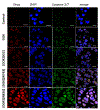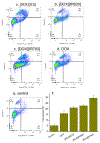Doxorubicin-Based Ionic Nanomedicines for Combined Chemo-Phototherapy of Cancer
- PMID: 38410412
- PMCID: PMC10896075
- DOI: 10.1021/acsanm.3c05464
Doxorubicin-Based Ionic Nanomedicines for Combined Chemo-Phototherapy of Cancer
Abstract
Synergistic combination therapy approach offers lots of options for delivery of materials with anticancer properties, which is a very promising strategy to treat a variety of malignant lesions with enhanced therapeutic efficacy. The current study involves a detailed investigation of combination ionic nanomedicines where a chemotherapeutic drug is coupled with a photothermal agent to attain dual mechanisms (chemotherapy (chemo) and photothermal therapy (PTT)) to improve the drug's efficacy. An FDA-approved Doxorubicin hydrochloride (DOX·HCl) is electrostatically attached with a near-infrared cyanine dye (ICG, IR783, and IR820), which serves as a PTT drug using ionic liquid chemistry to develop three ionic material (IM)-based chemo-PTT drugs. Carrier-free ionic nanomedicines (INMs) are derived from ionic materials (IMs). The photophysical properties of the developed combination IMs and their INMs were studied in depth. The phototherapeutic efficiency of the combination drugs was evaluated by measuring the photothermal conversion efficiency and singlet-oxygen quantum yield. The improved photophysical properties of the combination nanomedicines in comparison to their parent compounds significantly enhanced INMs' photothermal efficiency. Cellular uptake, dark and light toxicity studies, and cell death mechanisms of the chemo-PTT nanoparticles were also studied in vitro. The combination INMs exhibited enhanced cytotoxicity compared to their respective parent compounds. Moreover, the apoptosis cell death mechanism was almost doubled for combination nanomedicine than the free DOX, which is attributed to enhanced cellular uptake. Examination of the combination index and improved in vitro cytotoxicity results revealed a great synergy between chemo and PTT drugs in the developed combination nanomedicines.
Keywords: cell death mechanism; combination therapy; cytotoxicity; doxorubicin; ionic nanomaterial; photothermal therapy.
Conflict of interest statement
The authors declare no competing financial interest.
Figures







References
-
- Nierengarten MB Annual Report to the Nation on the Status of Cancer. Cancer 2023, 129 (1), 8. - PubMed
-
- Siegel RL; Miller KD; Wagle NS; Jemal A Cancer Statistics, 2023. CA, Cancer J. Clin 2023, 73 (1), 17–48. - PubMed
-
- Siegel RL; Miller KD; Fuchs HE; Jemal A Cancer Statistics, 2022. CA, Cancer J. Clin 2022, 72 (1), 7–33. - PubMed
-
- Yang G; Li M; Song T; Chen X; Zhang H; Wei X; Li N; Li T; Qin X; Li S; You F; Wu C; Zhang W; Liu Y; Yang H Polydopamine-Engineered Theranostic Nanoscouts Enabling Intracellular HSP90 MRNAs Fluorescence Detection for Imaging-Guided Chemo–Photothermal Therapy. Adv. Healthcare Mater 2022, 11 (23), 2201515. - PubMed
-
- Wang JJ; Lei KF; Han F Tumor Microenvironment: Recent Advances in Various Cancer Treatments. Eur. Rev. Med. Pharmacol. Sci 2018, 22 (12), 3855–3864. - PubMed
Grants and funding
LinkOut - more resources
Full Text Sources
